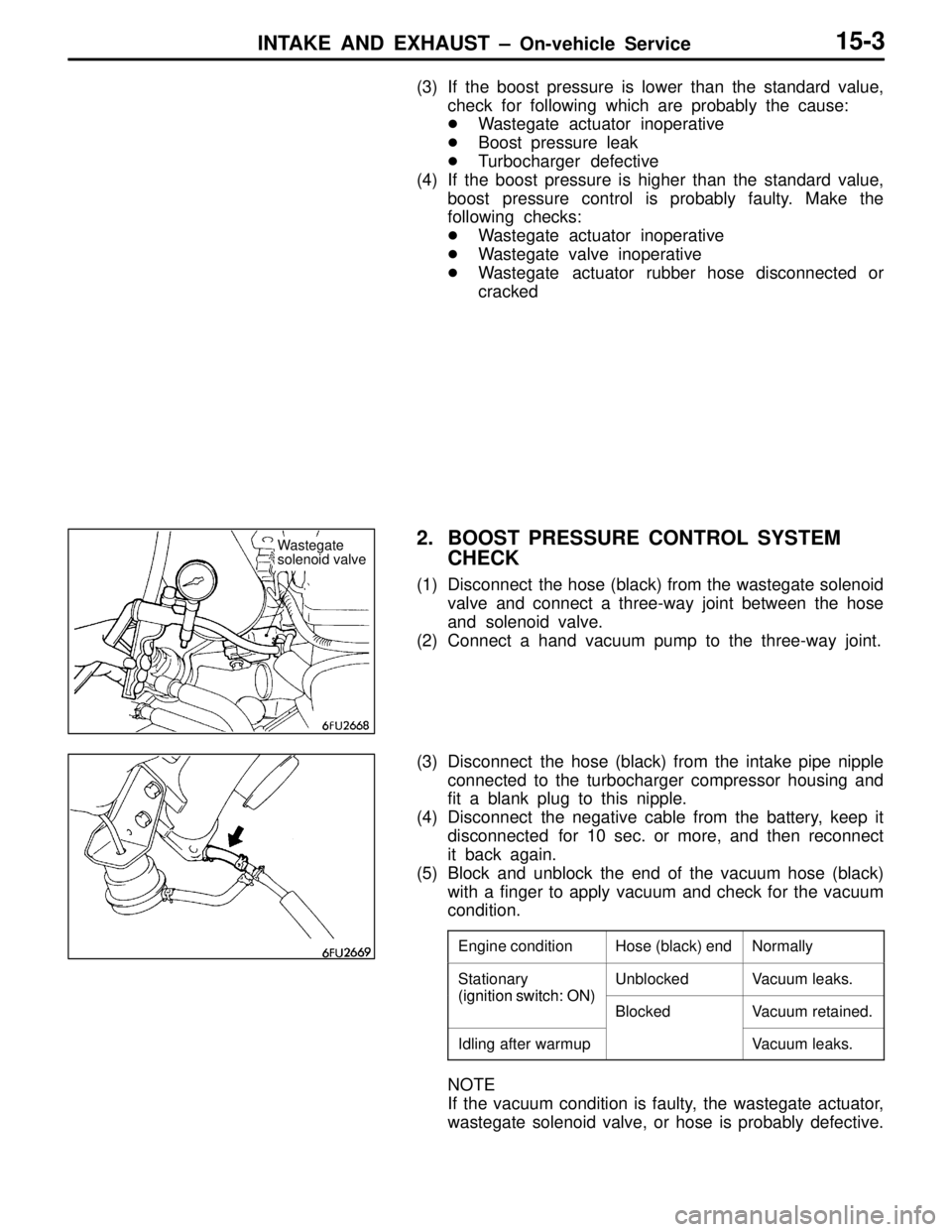Page 78 of 396
MPI – On-vehicle Service13-35
11. FUEL PUMP RELAY NO.2 CHECK
(1) Remove fuel pump relay No.2.
(2) Using jumper wires, connect fuel pump relay No.2 terminal
(3) to battery (+) terminal, and terminal (1) to battery
(–) terminal, respectively.
(3) Connecting and disconnecting the jumper wire on the
battery (–) terminal end, check for continuity across
terminal (2) and terminal (5), and across terminal (4) and
terminal (5), of fuel pump relay No.2.
Jumper wireContinuity across
terminals (2) and (5)Continuity across
terminals (4) and (5)
ConnectedNoYe s
DisconnectedYe sNo
(4) If the continuity is checked abnormally, replace fuel pump
relay No.2.
12. FUEL PUMP RESISTOR CHECK
(1) Disconnect the fuel pump resistor connector.
(2) Measure resistance across the terminals.
Standard value: 0.6 – 0.9 Ω
(3) If the measurement falls outside the specified range,
replace the fuel pump resistor.
Fuel pump relay No.2
Fuel pump resistor
Page 88 of 396
ENGINE COOLING – Radiator14-8
REMOVAL SERVICE POINTS
�A�RADIATOR UPPER HOSE / RADIATOR LOWER
HOSE DISCONNECTION
After making mating marks on the radiator hose and the hose
clamp, disconnect the radiator hose.
INSTALLATION SERVICE POINT
�A�RADIATOR LOWER HOSE / RADIATOR UPPER
HOSE CONNECTION
(1) Insert each hose as far as the projection of the water
inlet or outlet fitting.
(2) Align the mating marks on the radiator hose and hose
clamp, and then connect the radiator hose.
Caution
Fit the clamp on the hose at the same position as
before.
INSPECTION
1. RADIATOR FAN MOTOR CHECK
Apply the battery voltage across connector terminals 1 and
2, and terminals 3 and 4, of the radiator fan motor and check,
at that time, that the radiator fan turns.
2. POWER RELAY CONTINUITY CHECK
Battery voltageTerminal number
1345
When deenergized
When energized
Radiator fan motor relay LO
Page 89 of 396
ENGINE COOLING – Radiator14-9
Battery voltageTerminal number
1234
When deenergized
When energized
Radiator fan motor relay HI
Page 92 of 396

INTAKE AND EXHAUST – On-vehicle Service15-3
(3) If the boost pressure is lower than the standard value,
check for following which are probably the cause:
�Wastegate actuator inoperative
�Boost pressure leak
�Turbocharger defective
(4) If the boost pressure is higher than the standard value,
boost pressure control is probably faulty. Make the
following checks:
�Wastegate actuator inoperative
�Wastegate valve inoperative
�Wastegate actuator rubber hose disconnected or
cracked
2. BOOST PRESSURE CONTROL SYSTEM
CHECK
(1) Disconnect the hose (black) from the wastegate solenoid
valve and connect a three-way joint between the hose
and solenoid valve.
(2) Connect a hand vacuum pump to the three-way joint.
(3) Disconnect the hose (black) from the intake pipe nipple
connected to the turbocharger compressor housing and
fit a blank plug to this nipple.
(4) Disconnect the negative cable from the battery, keep it
disconnected for 10 sec. or more, and then reconnect
it back again.
(5) Block and unblock the end of the vacuum hose (black)
with a finger to apply vacuum and check for the vacuum
condition.
Engine conditionHose (black) endNormally
Stationary
(ignition switch: ON)
UnblockedVacuum leaks.
(ignition switch: ON)
BlockedVacuum retained.
Idling after warmupVacuum leaks.
NOTE
If the vacuum condition is faulty, the wastegate actuator,
wastegate solenoid valve, or hose is probably defective.
Wastegate
solenoid valve
Page 93 of 396

INTAKE AND EXHAUST – On-vehicle Service15-4
3. WASTEGATE ACTUATOR CHECK
(1) Connect a hand pump (pressure type) to the nipple.
(2) Gradually increase the pressure being applied to check
for the pressure at which the wastegate actuator rod starts
moving (approx. 1 mm stroke).
Standard value: Approx. 100 kPa {1.02 kg/cm
2}
Caution
Do not apply a pressure more than 120 kPa {1.23
kg/cm
2} to prevent the diaphragm from being
damaged.
(3) If the pressure drastically deviates from the standard
value, check the actuator or wastegate valve and, if
necessary, replace the actuator or turbocharger assembly.
4. WASTEGATE SOLENOID VALVE CHECK
4-1 OPERATION CHECK
(1) Connect a hand vacuum pump to nipple A of the solenoid
valve.
(2) Using jumper wires, connect the solenoid valve terminal
to battery terminals.
(3) Disconnecting and reconnecting the jumper wire on the
(–) terminal side, apply vacuum to check for airtightness.
Jumper wireNipple B conditionNormally
ConnectedOpenVacuum leaks.
PluggedVacuum retained.
DisconnectedOpenVacuum retained.
4-2 COIL RESISTANCE CHECK
Measure the resistance across solenoid valve terminals.
Standard value: 62 – 74 Ω (at 20�C)
5. AIR BYPASS VALVE CHECK
(1) Remove the air bypass valve.
(2) Connect a hand vacuum pump to the air bypass valve
nipple.
(3) Apply a vacuum of approx. 45 kPa {340 mmHg} and
check that the valve is airtight.
(4) Increase the vacuum and check for valve operation.
VacuumValve operation
Approx. 53 kPa {400 mmHg}Starts moving
Page 94 of 396

INTAKE AND EXHAUST – On-vehicle Service15-5
6. SECONDARY AIR CONTROL SYSTEM
CHECK
(1) Start the engine and let it run at idle speed.
(2) Short-circuit the no. 6 terminal of the engine ECU
connector using a jumper wire and check at this time
that the secondary air valve lifts.
At this time, the engine ECU connector should be
connected.
7. SECONDARY AIR CONTROL SOLENOID
VALVE CHECK
7-1 OPERATION CHECK
(1) Disconnect the vacuum hose (white stripe, yellow stripe)
from the solenoid valve.
(2) Disconnect the harness connector.
(3) Connect a hand vacuum pump to nipple A of the solenoid
valve.
(4) Using jumper wires, connect the solenoid valve terminal
to battery terminals.
(5) Disconnecting and reconnecting the jumper wire on the
(–) terminal side, apply vacuum to check for airtightness.
Jumper wireNipple B conditionNormally
ConnectedOpenVacuum leaks.
PluggedVacuum retained.
DisconnectedOpenVacuum leaks.
7-2 COIL RESISTANCE CHECK
Measure the resistance across solenoid valve terminals.
Standard value: 28 – 36 Ω (at 20�C)
Secondary air control
solenoid valve
Battery
Page 127 of 396

MANUAL TRANSMISSION – Transmission Assembly22A-7
TRANSMISSION ASSEMBLY
REMOVAL AND INSTALLATION
Pre-removal Operation
(1) Transmission Oil Draining (Refer to P.22A-3.)
(2) Transfer Oil Draining (Refer to P.22A-3.)
(3) Under Cover Removal
(4) Front Exhaust Pipe Removal (Refer to GROUP 15.)
(5) Battery and Battery Tray Removal
(6) Air Cleaner Assembly RemovalPost-installation Operation
(1) Air Cleaner Assembly Installation
(2) Battery and Battery Tray Installation
(3) Front Exhaust Pipe Installation
(Refer to GROUP 15.)
(4) Under Cover Installation
(5) Transfer Oil Supplying (Refer to P.22A-3.)
(6) Transmission Oil Supplying (Refer to P.22A-3.)
(7) Shift Lever Operation Check
(8) Speedometer Operation Check
1
2
34 5
6
7
8 8
Unit: Nm {kgf�m}
49 {5.0} 98 {10.0}*
88 {9.0}19 {1.9}
48 {4.9}19 {1.9}
Removal steps
1. Shift cable and select cable con-
nection
2. Backup lamp switch connector
3. Vehicle speed sensor connector
�A�4. Starter motor
5. Clutch release cylinder connection
6. Transmission assembly upper part
coupling bolts7. Transmission mount bracket
8. Transmission mount stopper
�Engine assembly supporting
Caution
Mounting locations marked by * should be
provisionally tightened, and then fully tightened
when the body is supporting the full weight of the
engine.
Page 187 of 396

27-1
REAR AXLE
CONTENTS
SERVICE SPECIFICATIONS 2. . . . . . . . . . . . . .
LUBRICANT 2. . . . . . . . . . . . . . . . . . . . . . . . . . . . .
SEALANT 2. . . . . . . . . . . . . . . . . . . . . . . . . . . . . . .
SPECIAL TOOLS 3. . . . . . . . . . . . . . . . . . . . . . . .
TROUBLESHOOTING 5. . . . . . . . . . . . .
ON-VEHICLE SERVICE
27. . . . . . . . . . . . . . .
1. Rear Axle Total Backlash Check 27. . . . . . .
2. Gear Oil Level Check 27. . . . . . . . . . . . . . . .
3. Gear Oil Change 28. . . . . . . . . . . . . . . . . . . . .
4. Fluid Level Check 29. . . . . . . . . . . . . . . . . . . .
5. Bleeding 29. . . . . . . . . . . . . . . . . . . . . . . . . . . . .
6. Differential Carrier Oil Seal
Replacement 30. . . . . . . . . . . . . . . . . . . . . . . . .
7. Speed Sensor Output Voltage
Measurement 31.
8. Action When Battery Runs Out 32. . . . . . . .
REAR HUB ASSEMBLY 33. . . . . . . . . . . . . . . .
KNUCKLE 35. . . . . . . . . . . . . . . . . . . . . . . . . . . . .
DRIVE SHAFT 36. . . . . . . . . . . . . . . . . . . . . . . . .
DIFFERENTIAL CARRIER
39.
DIFFERENTIAL CARRIER
41. . . . . . . . . . . . . . . . . . .
TORQUE TRANSFER DIFFERENTIAL
43. . . . . . . . . . . . . . .
LSD CASE ASSEMBLY
46. . . . . . . . . . .
HYDRAULIC UNIT
50. . . . . . . . . . . . . . .
SENSOR RELAY
52. . . . . . . . . . . . . . .
AYC-ECU 53. . . . . . . . . . . . . . . . . . . . . . . . . . . . . .